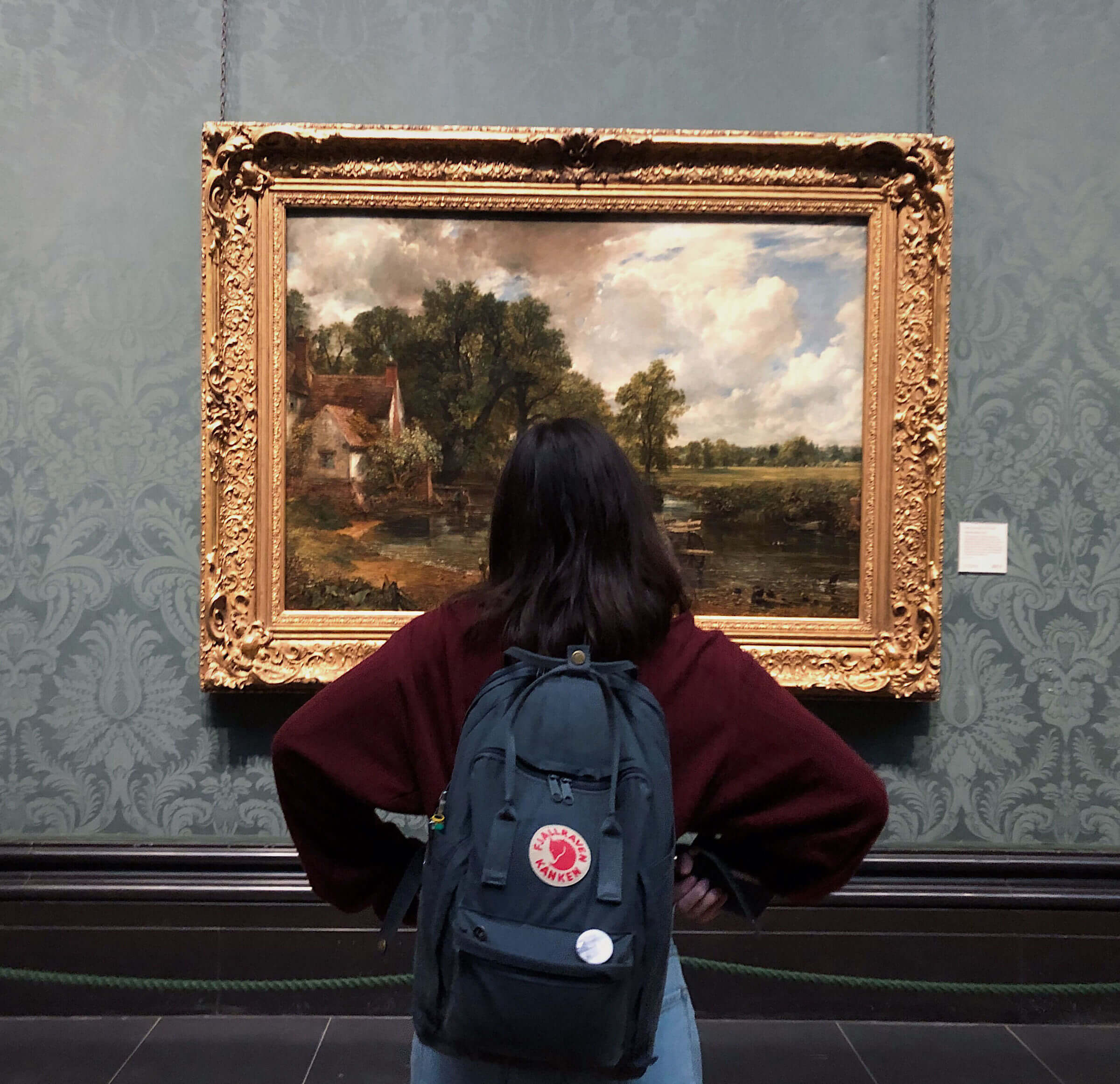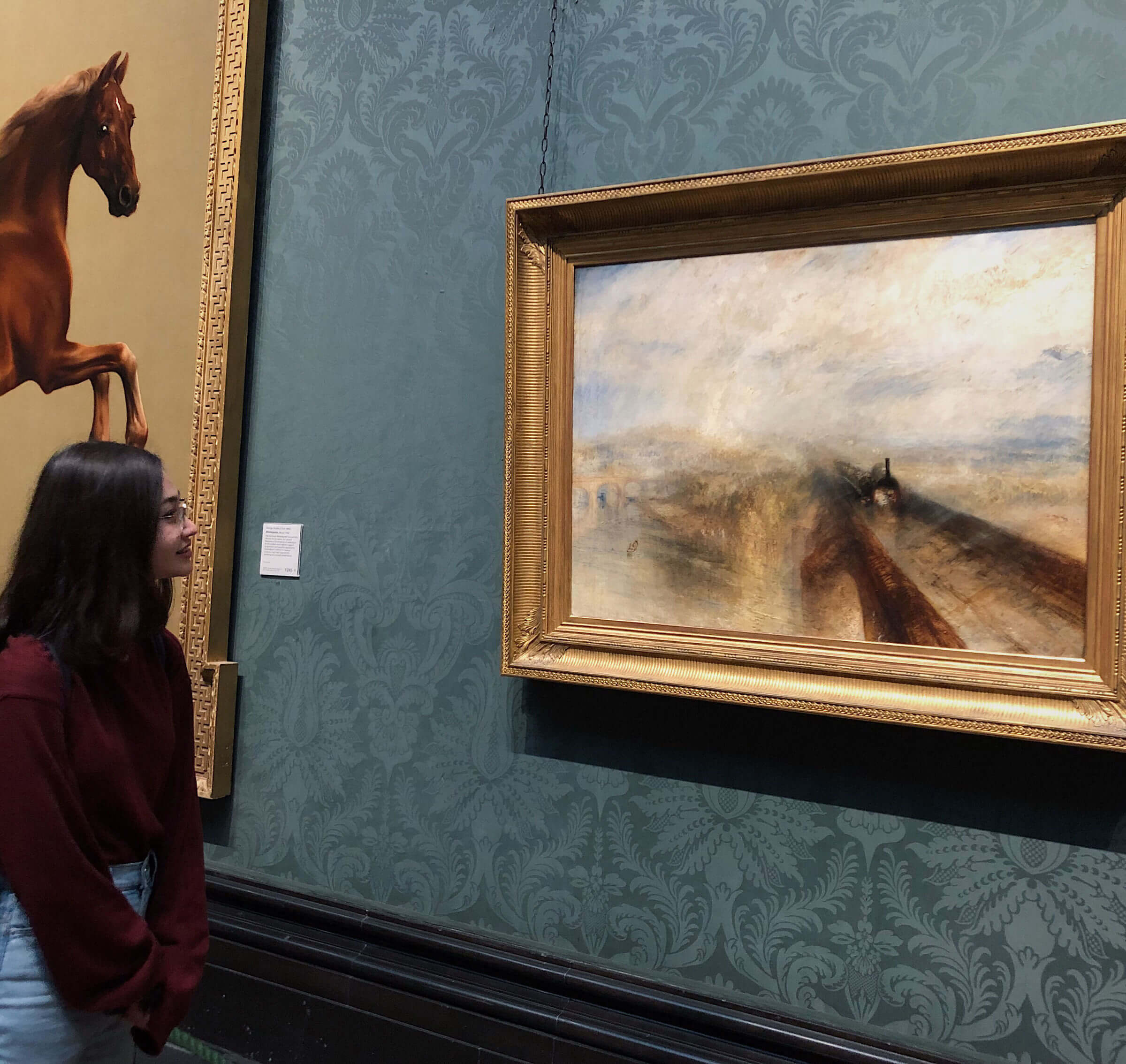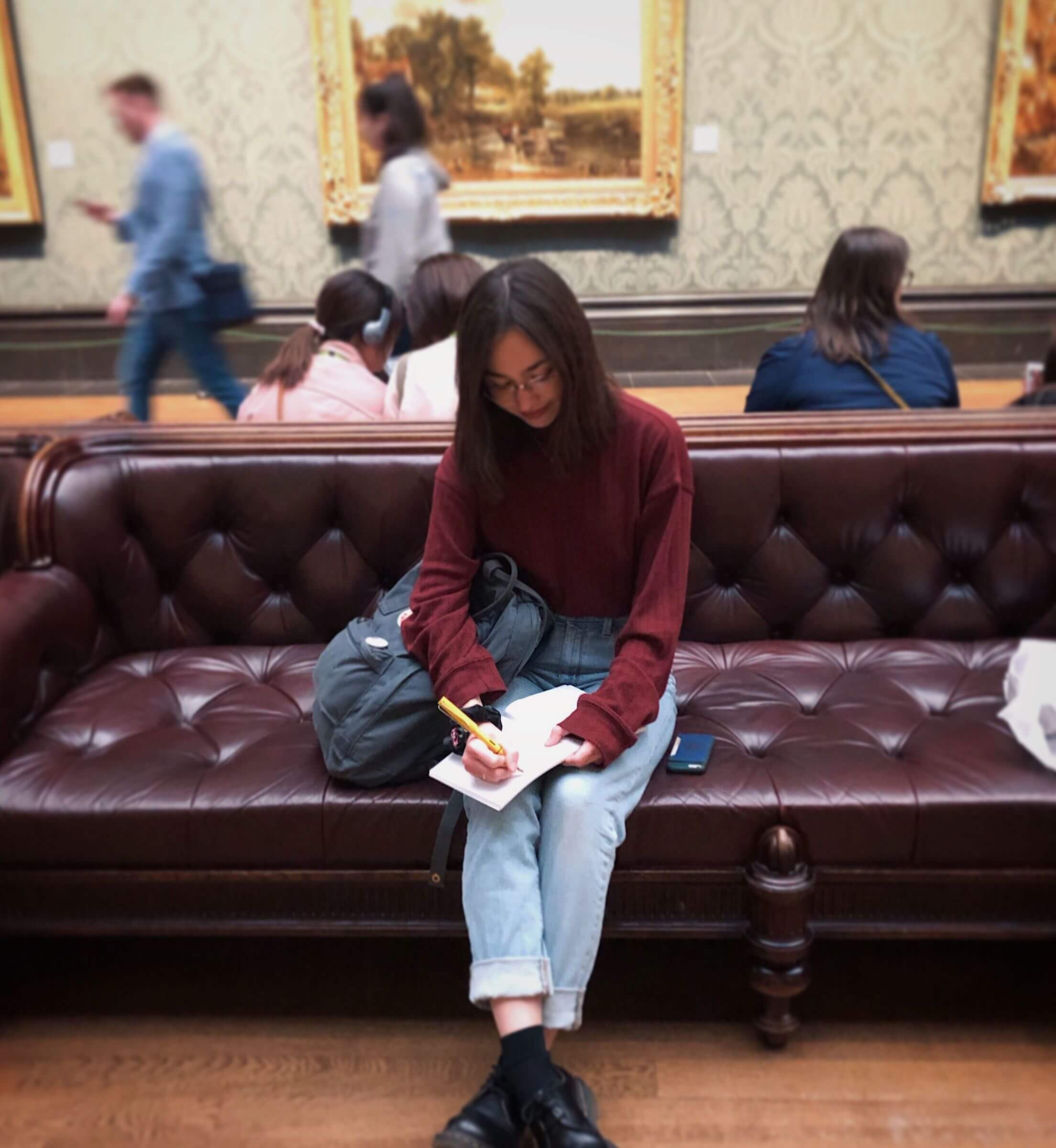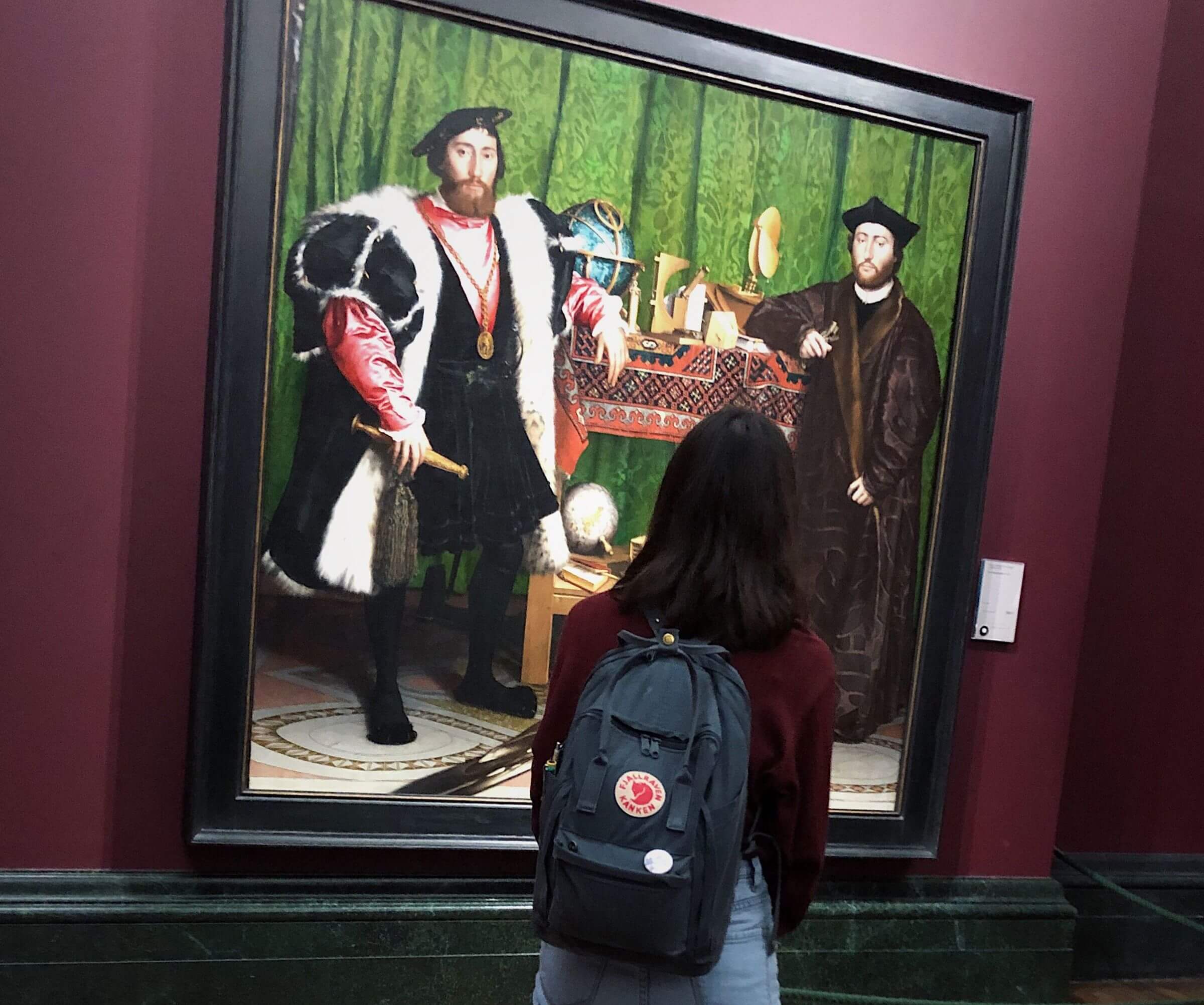Living out a dream: Artistic immersion in London
 Mills at the National Gallery
Mills at the National Gallery
In her application for the London Global Gateway, Rachel Mills described a daydream that she often had in South Bend. The fantasy scenario involved her exiting the tube station into Trafalgar Square, and walking through crowds of buskers, commuters and tourists to reach her place of work: the National Gallery.
While a career at the National Gallery remains an ambition for Mills, her time in London brought her vision to life in more ways than she ever expected.
“I stop into the National Gallery everyday I have class”, says Mills. “It’s the closest experience I’ll ever have to living with art."
Artistic immersion
The London Global Gateway is nestled just behind Trafalgar square, a stone’s throw from the National Gallery and walking distance to innumerable iconic galleries in London. This situation was perfect for Mills, who was able to take immersive art history courses that make full use of the magnificent London art collections, experienced first hand.
Most students would be satisfied by this level of immersion, but Mills took it even further, spending her free time exploring different galleries and using the space in every way possible.
“I sit there and journal or read for a class and actually live with the art,” says Mills.
In such a digital age, where it is possible to see masterpieces on screen in a matter of seconds, many question the point of seeing art in person. Mills is not one of these people. Whether it’s the build up of brush strokes, the almost invisible repair marks, or the actual space the work is housed in, Mills believes that seeing the work first hand is invaluable.
“There’s a richer, deeper connection with works of art,” she reflects. “Nothing compares to seeing them in person.”
 Mills studying art up close
Mills studying art up close
Drawing connections
One of the classes Mills has taken this semester is "Masterpieces: Making and Meaning," taught by Lois Oliver, who for ten years was a curator and exhibition organizer at the National Gallery and V&A. This contact with Oliver has allowed Mills to think further about pieces of art, drawing connections between how pieces were made, their history, and how this fits into British culture.
Oliver’s insider knowledge of the art gave Mills a richer understanding of the masterpieces they were studying. To illustrate this, Mills points to the history of Velázquez's Rokeby Venus. The painting was slashed by one of the suffragettes in 1914, in what many might assume was a protest against the objectification of the female body in art. Through Oliver’s teaching however, Mills learned that this was not necessarily the case.
“One of the founders of the suffragette movement was in prison on hunger strike and Mary Richardson, who attacked the picture, was making the point that her society seemed to value this image of a woman more that an actual woman,” explains Mills. “She believed justice and truth is just as much as an element of beauty as paint on a canvas.”
The National Gallery does not mention the attack in its gallery interpretation, and in fact, it is easy to miss the very faint repair lines if you are not actively searching for them.
“There is so much additional history wrapped up in this work that can connect to British culture that I would have never known if I wasn’t taking the class,” reflects Mills.
As a former curator, Oliver was able to offer Mills a deeper understanding of the art she was studying, but also show her that the galleries' impact on how the work is presented to the public.
“She has insider knowledge about how the National Gallery approaches the history of different pieces of work,” says Mills. “To hear her thoughts on that is so fascinating.”
The power of the space
 Mills writing in her diary at one of London's galleries
Mills writing in her diary at one of London's galleries
Mills works with the Snite Museum of Art at Notre Dame, and is involved in their education department, as well as helping think about their construction of a new art museum on campus. Her time in London museums and galleries has inspired her to think more creatively about the different spaces that house the art, and how they facilitate and encourage different interactions.
“I’ve started to think about how we can activate space in different ways and really make interdisciplinary space that can connect to a bunch of different departments and groups on campus,” says Mills.
Museums and galleries are social, educational and cultural spaces, with open doors to visitors of all ages, backgrounds and interests. It is important then, for the spaces to constantly evolve and develop new ways of connecting with their audiences. During her time in London, Mills has experimented with the different ways users can experience gallery and museum space, particularly focusing on living with the art.
“I go repeatedly so that I can wander without an aim and use it almost as a living space,” says Mills.
When she returns to campus, Mills hopes to import some of the knowledge she has gained and apply it to the new building for the Snite Museum, encouraging diversity in and through the use of the space.
 Mills on her daily visit to the National Gallery
Mills on her daily visit to the National Gallery
Looking to the future
Towards the end of her time in London, Mills made the decision to drop her program of liberal studies major and pursue an art history honors full major, writing her senior thesis in art history. While this decision had been in the back of her mind for some time, her experience at the gateway confirmed that this was the right avenue for her.
“All of the amazing art museums and galleries in London was the key factor that brought me here,” says Mills.
Although she’s sad to leave a city so rich in arts and culture, Mills is looking forward to getting back to her work on campus, and particularly the Snite Museum. She has not said goodbye to the city however, and hopes to return to London to pursue a masters in art history.
“I would love to return to London, that’s now my dream,” smiles Mills.
Her time in London has given her new ambitions and goals, and she’s going back to Notre Dame to figure out exactly how to make her dreams a reality.
About Lois Oliver’s classes
For ten years, Lois worked at the V&A and the National Gallery, where she curated a series of exhibitions and worked on major redisplays of the permanent collections. Currently Associate Professor in History of Art at the London Global Gateway, she is also a visiting lecturer at the Courtauld Institute, and writes audio and multimedia tours for the National Gallery, Royal Academy, Royal Collection and Tate. Oliver offers three classes to students at the London Global Gateway:
Masterpieces: making and meaning explores in depth 12 “masterpieces” of European art in London collections, by celebrated artists including Holbein, Titian, Rubens, Rembrandt, Velazquez, Turner, Manet and Van Gogh.
Encounters: Art in London and Paris c. 1850-1900 examines the extraordinarily rich developments in art in London and Paris during the second half of the nineteenth century, focusing on key artists from France, Britain and the USA, and includes study visits in London and Paris.
London as Art Capital is an immersive course exploring how artists, art markets, museums and galleries operate in this major metropolis. As part of this course, students work as volunteers on the pioneering museum education and outreach programs run by Dulwich Picture Gallery, the world’s first purpose-built public art gallery. This is an international community engagement course, developed in collaboration with the UND Center for Social Concerns.